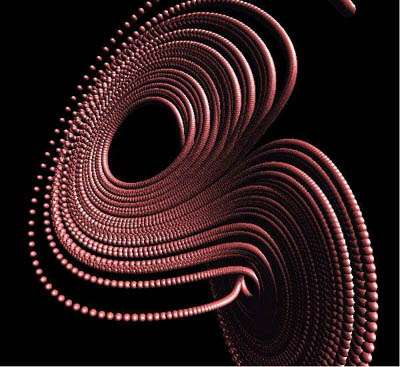Principal | Gráficos 3D | Gráficos 2D | Fractales | Math | Códigos | Tutoriales | Links
Otro sistema de ecuaciones diferenciales que presenta CAOS es el de Lorenz, el cual es una simplificación de las ecuaciones originales que encontró en la predicción del tiempo.
|
con los siguientes parametros p=10, r=28 y b=8/3
Utilizó el Método de Euler para resolver el sistema, las condiciones iniciales del sistema son x(0)=1.0, y(0)=1.0, z(0)=1.0 y utilizo un tamaño de paso h=0.001.
| r1=0.0, r2=0.0, r3=0.0 |
|---|
donde r1, r2, r3 son la rotación con respecto a los ejes x, y, z respectivamente en radianes.
Código que se encarga de resolver el sistema de ecuaciones y graficarlo en 3D lorenz.zip (2 Kb)
Option Explicit
Const MaxPuntos = 100000
Const FactorDeEscala = 2
Dim r1, r2, r3 As Double
Dim sr1, sr2, sr3, cr1, cr2, cr3 As Double
Dim sx, sy As Double
Dim ScreenX, ScreenY As Long
Function dx(ByVal x As Double, ByVal y As Double, ByVal z As Double) As Double
dx = 10# * (y - x)
End Function
Function dy(ByVal x As Double, ByVal y As Double, ByVal z As Double) As Double
dy = -x * z + 28 * x - y
End Function
Function dz(ByVal x As Double, ByVal y As Double, ByVal z As Double) As Double
dz = x * y - (8 / 3) * z
End Function
Sub SinCos()
sr1 = Sin(r1)
sr2 = Sin(r2)
sr3 = Sin(r3)
cr1 = Cos(r1)
cr2 = Cos(r2)
cr3 = Cos(r3)
End Sub
Sub Calc3D(ByVal x As Double, ByVal y As Double, ByVal z As Double)
Dim xa, ya, za As Double
x = FactorDeEscala * x
y = FactorDeEscala * y
z = FactorDeEscala * z
x = (-1#) * x
xa = cr1 * x - sr1 * z
za = sr1 * x + cr1 * z
x = cr2 * xa + sr2 * y
ya = cr2 * y - sr2 * xa
z = cr3 * za - sr3 * ya
y = sr3 * za + cr3 * ya
z = z - 350
sx = (1200 * x) / z
sy = (1200 * y) / z
End Sub
Sub Lorenz()
Dim x, y, z As Double
Dim h As Double
Dim nPuntos As Long
Picture1.Cls
Call SinCos
x = 1#
y = 1#
z = 1#
nPuntos = 0
h = 0.001
Do While (nPuntos < MaxPuntos)
x = x + h * dx(x, y, z)
y = y + h * dy(x, y, z)
z = z + h * dz(x, y, z)
Call Calc3D(x, y, z)
sx = sx + ScreenX / 2#
sy = sy + ScreenY / 2#
Picture1.PSet (sx, ScreenY - sy), RGB(255, 0, 0)
nPuntos = nPuntos + 1
Loop
End Sub
Private Sub cmdEjecutar_Click()
r1 = 0#
r2 = 0#
r3 = 0#
Call Lorenz
End Sub
Private Sub cmdSalir_Click()
Unload Me
End Sub
Private Sub Form_Load()
Picture1.ScaleMode = 3
ScreenX = Picture1.ScaleWidth
ScreenY = Picture1.ScaleHeight
End Sub
|
Las condiciones iniciales son las mismas x(0)=1.0, y(0)=1.0, z(0)=1.0 y el tamañao de paso h=0.05, con 12.000 esferas.

|
| gluLookAt (15.0, -25.0, 0.0, 0.0, 0.0, 25.0, 0.0, 1.0, 0.0) |
|---|
Los archivos necesarios para la compilacion del código se encuentan en lorenz_c.zip (3 Kb)
La libreria GLUT 3.6 se la puede enconotrar en http://reality.sgi.com/opengl/glut3/glut3.html
Acerca de la instalción de GLUT, se debe decomprimir el archivo glutdlls36.zip y copiar el archivo GLUT32.DLL en el directorio WINDOWS/SYSTEM, copiar el archivo GLUT32.LIB en el subdirectorio del compilador destinado a las librerias, y el archivo GLUT.H junto con el resto de los includes de OpenGL.
#include <GL/glut.h>
#include <stdlib.h>
GLfloat diffuseMaterial[4] = {0.75, 0.75, 0.75, 1.0};
void init(void)
{
GLfloat mat_specular[] = {1.0, 1.0, 1.0, 1.0};
GLfloat light_position[] = {1.0, 1.0, 1.0, 0.0};
glClearColor (0.0, 0.0, 0.0, 0.0);
glShadeModel (GL_SMOOTH);
glEnable(GL_DEPTH_TEST);
glMaterialfv(GL_FRONT, GL_DIFFUSE, diffuseMaterial);
glMaterialfv(GL_FRONT, GL_SPECULAR, mat_specular);
glMaterialf(GL_FRONT, GL_SHININESS, 25.0);
glLightfv(GL_LIGHT0, GL_POSITION, light_position);
glEnable(GL_LIGHTING);
glEnable(GL_LIGHT0);
glColorMaterial(GL_FRONT, GL_DIFFUSE);
glEnable(GL_COLOR_MATERIAL);
}
void display(void)
{
GLfloat x0, y0, z0, x1, y1, z1;
GLfloat h;
int Puntos, MaxPuntos=12000;
glClear (GL_COLOR_BUFFER_BIT | GL_DEPTH_BUFFER_BIT);
glColor3f (1.0, 1.0, 1.0);
glLoadIdentity ();
gluLookAt (15.0, -25.0, 0.0, 0.0, 0.0, 25.0, 0.0, 1.0, 0.0);
glColor3f(1.0f, 0.4f, 0.4f);
x0=1.0f;
y0=1.0f;
z0=1.0f;
Puntos=0;
h=0.005f;
while (Puntos<MaxPuntos)
{
x1=x0+h*(10.0f*(y0-x0));
y1=y0+h*(x0*(28.0f-z0)-y0);
z1=z0+h*(x0*y0-(8.0f/3.0f)*z0);
x0=x1;
y0=y1;
z0=z1;
glPushMatrix();
glTranslatef(x0, y0, z0);
glutSolidSphere(0.5, 12.0, 12.0);
glPopMatrix();
Puntos=Puntos+1;
}
glFlush ();
}
void reshape (int w, int h)
{
glViewport (0, 0, (GLsizei) w, (GLsizei) h);
glMatrixMode (GL_PROJECTION);
glLoadIdentity ();
glFrustum (-1.0, 1.0, -1.0, 1.0, 1.5, 200.0);
glMatrixMode (GL_MODELVIEW);
}
/* ARGSUSED1 */
void keyboard(unsigned char key, int x, int y)
{
switch (key) {
case 27:
exit(0);
break;
}
}
int main(int argc, char** argv)
{
glutInit(&argc, argv);
glutInitDisplayMode (GLUT_SINGLE | GLUT_RGB);
glutInitWindowSize (600, 600);
glutInitWindowPosition (0, 0);
glutCreateWindow (argv[0]);
init ();
glutDisplayFunc(display);
glutReshapeFunc(reshape);
glutKeyboardFunc(keyboard);
glutMainLoop();
return 0;
}
|
valcoey@hotmail.com
Ramiro Alcocer, 2001
Principal | Gráficos 3D | Gráficos 2D | Fractales | Math | Códigos | Tutoriales | Links